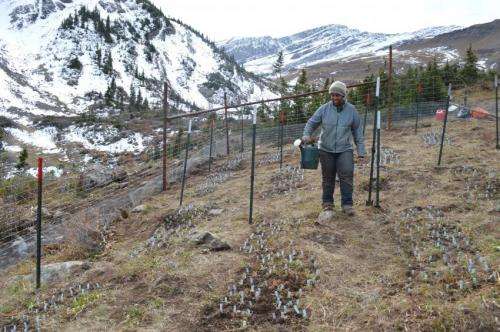Shape-shifting may help some species cope with climate change, study shows

Researchers have found that a Rocky Mountain mustard plant alters its physical appearance and flowering time in response to different environmental conditions, suggesting some species can quickly shape-shift to cope with climate change without having to migrate or evolve.
The findings appear in the journal Global Change Biology. The study was conducted by researchers from Dartmouth College and the University of South Carolina at the Rocky Mountain Biological Laboratory.
Scientists studying climate change's impact on species typically focus on changes in their geographic distribution and, to a lesser extent, on their genetic potential to evolve rapidly. But it's also known that changing conditions can prompt immediate shifts in organisms' physical traits—or what researchers call phenotypic plasticity, which allows for different looking organisms without changing their genetic code. What's less certain is whether that physical shape-shifting will reduce extinction risks under climate change. As climate change advances, phenotypic plasticity could enable some species to remain in place and give others enough time to allow migration and adaptation to occur. Alternatively, climate change could cause some species to physically change in ways that reduce their fitness and stall their adaptation and migration.
In the new study, researchers looked at the life history, leaf shape, flowering time and other characteristics of a native wild mustard plant at different elevations in the Rocky Mountains, where warming winters are reducing snowpack and warming springs are causing an earlier snow melt. They found that the forb's traits consistently vary over a temperature and moisture gradient from low elevations with a hot, dry climate to high elevations with wet, cold conditions. The researchers then went to an intermediate elevation and simulated climate change by reducing the snowpack, which made the plants flower seven days early, similar in magnitude to flowering time shifts over 20 to 30 years of climate change. The mid-elevation forbs that were coxed into flowering early took on the appearance of the low elevation plants, although some ended up with unexpected and unique combinations of traits. The results show the plants have great phenotypic plasticity and do not all change in the same ways.
'Because climate change affects some environmental factors like precipitation and temperature but not others like day length, phenotypic plasticity could allow some species to persist in a habitat despite changing conditions and provide more time for them to evolve and migrate,' says co-author Zachariah Gezon, a Ph.D. student in Ecology and Evolutionary Biology at Dartmouth.
Journal information: Global Change Biology
Provided by Dartmouth College



















